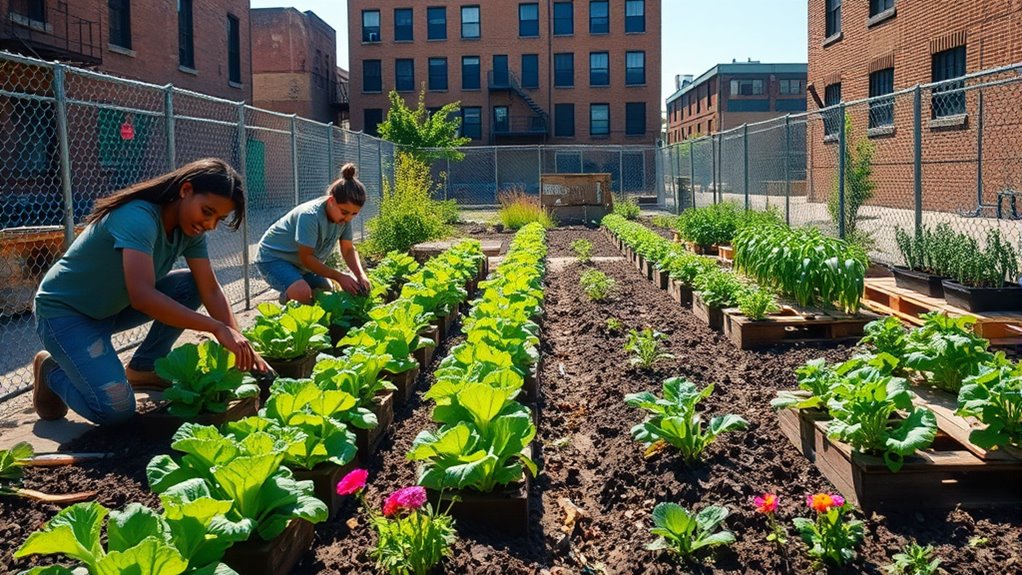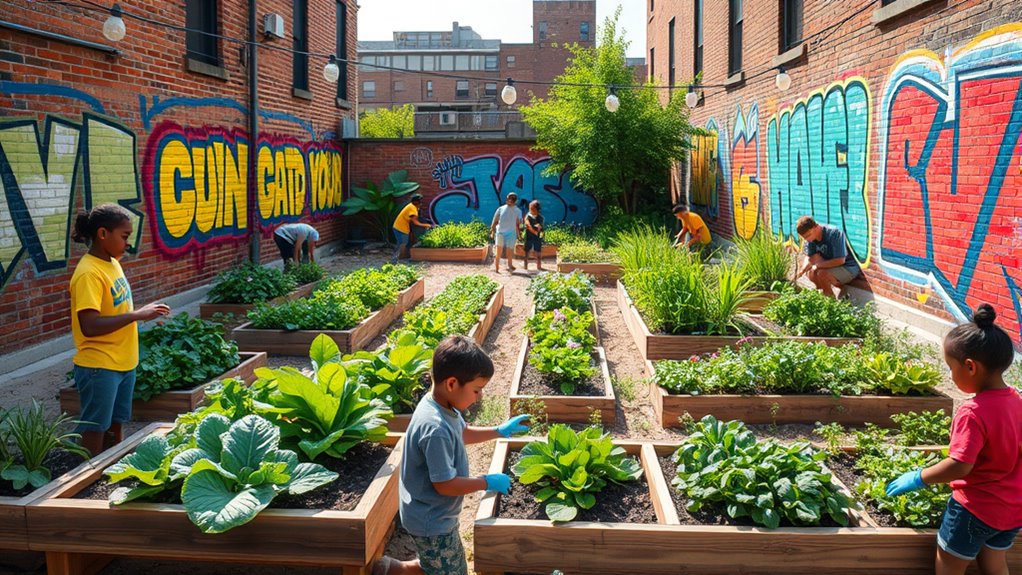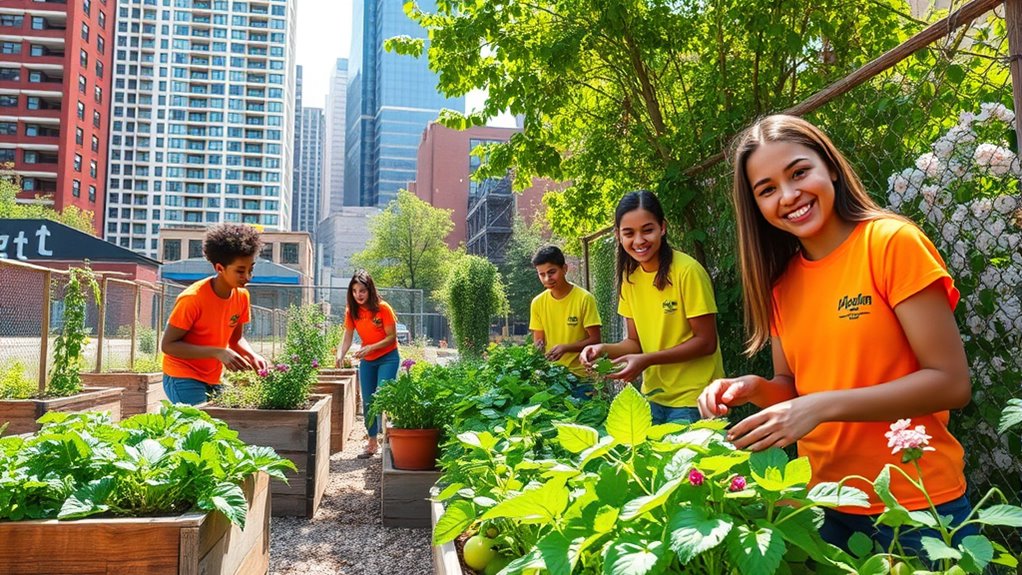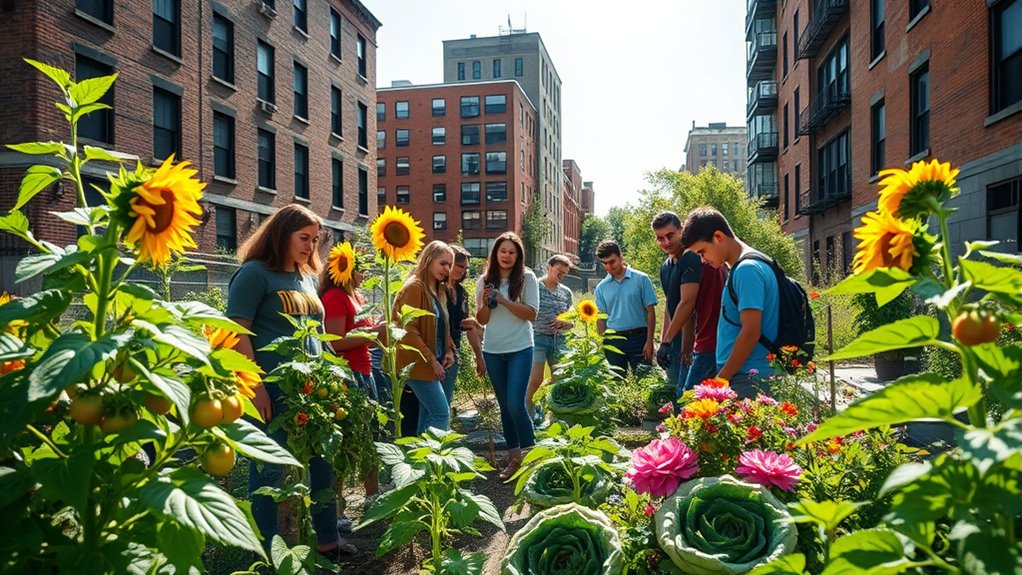Urban teens transforming vacant lots into vibrant gardens prove how green spaces boost neighborhood safety, mental health, and community pride. These projects reduce crime rates, increase property values, and provide fresh food options, helping fight food insecurity. The efforts foster responsibility, resilience, and stronger bonds among residents. If you’re curious about how these green transformations create lasting change and inspire communities, there’s more to discover below.
Key Takeaways
- Urban teens transformed a vacant lot into a vibrant community garden, promoting environmental sustainability and neighborhood revitalization.
- The project boosted teen well-being by providing a safe space for relaxation, socialization, and emotional growth.
- Green space creation led to reductions in local crime rates, enhancing neighborhood safety and security.
- The garden increased property values and offered residents access to fresh produce, improving food security.
- Community involvement fostered ownership, pride, and ongoing maintenance of the green oasis.
Revitalizing Neighborhoods Through Green Spaces

Transforming vacant lots into green spaces has a powerful impact on neighborhood revitalization. When you turn neglected, overgrown lots into vibrant parks, gardens, or community spaces, you breathe new life into your community. These green spaces attract residents, encourage outdoor activity, and create a sense of pride. They also serve as a foundation for social interactions, fostering stronger connections among neighbors. As vacant lots are transformed, areas that once seemed abandoned or unsafe become lively, welcoming places. This change not only beautifies neighborhoods but also boosts local economies by increasing property values and attracting new residents. Incorporating native plantings can further enhance environmental benefits and sustainability. Utilizing sustainable landscaping practices also helps reduce maintenance costs and water usage over time. Additionally, engaging local youth in planting and maintaining these spaces can promote community involvement and stewardship. When residents participate in these projects, it can lead to increased community ownership, ensuring the ongoing success of green initiatives. Ultimately, greening vacant lots helps stabilize neighborhoods, making them safer, healthier, and more connected places to live. Emphasizing urban greening initiatives can accelerate these positive transformations and foster a sense of ownership among residents.
The Impact on Teen Well-Being and Mental Health

When vacant lots are transformed into green spaces, you’ll notice teens feeling happier and more connected to their community. These improvements can also help reduce stress and anxiety, making their daily lives more manageable. As more teens experience these benefits, it’s clear that urban greening has a powerful impact on mental health. Additionally, engaging in gardening can foster a sense of responsibility and purpose among teens, further supporting their emotional well-being asset division impacts. Incorporating mindfulness techniques like gardening can also promote physical activity and a sense of achievement, enhancing overall mental resilience. Creating a community garden can serve as a support system that encourages ongoing engagement and collective care. Studies show that urban greening initiatives can lead to sustained improvements in community cohesion and youth development.
Boosts Teen Happiness
Greening vacant lots in underresourced neighborhoods directly boosts teen happiness by creating inviting, safe spaces where young people can relax, socialize, and connect with nature. These transformed areas provide a sense of ownership and pride, helping teens feel more connected to their community. When you spend time in these green spaces, you can escape everyday stress, enjoy fresh air, and build friendships with peers. The improvements not only make neighborhoods more attractive but also foster positive interactions that enhance your overall mood. As you participate in gardening or community activities, you gain a sense of purpose and achievement. This environment promotes feelings of happiness and belonging, helping you feel more hopeful and resilient amid challenging circumstances. Incorporating reliable backup power solutions into community projects can ensure that these green spaces remain accessible and safe during emergencies, further supporting teen well-being. Additionally, access to sustainable energy sources can help maintain the vitality of these spaces over time and promote mindfulness by encouraging a deeper connection to the environment. Moreover, implementing emergency preparedness strategies can further protect these spaces and the teens who rely on them during unforeseen events. A focus on community engagement can also foster sustained interest and participation in maintaining these green areas.
Reduces Stress and Anxiety
Living in neighborhoods with neglected or decaying environments can cause significant stress and anxiety, especially for teens. When areas are overgrown, trash-strewn, or unsafe, you might feel overwhelmed or fearful. Turning vacant lots into green spaces changes that. Greened spaces provide a calming environment where you can breathe, relax, and reconnect with nature. Studies show that exposure to greenery reduces feelings of depression and worry, helping you feel more centered. After greening efforts, teens report lower stress levels and greater peace of mind. These safe, welcoming environments foster a sense of belonging and control. As you spend time in these spaces, your anxiety diminishes, and your mood improves. Overall, transforming vacant lots into gardens directly supports your mental health and emotional resilience, promoting a sense of environmental well-being. Additionally, engaging in dynamic communication exercises during community projects can strengthen bonds among neighbors and encourage collective care. Incorporating air quality improvement strategies can further enhance the health benefits of these green spaces.
Community-Led Transformation and Engagement

How do communities take charge of transforming vacant lots into vibrant public spaces? People like you step up by proposing ideas, organizing cleanups, and collaborating with local groups. Residents often informally adopt lots, turning them into community gardens or parks without waiting for official help. Local organizations partner with city agencies to remove trash, mow overgrown grass, and build features like playgrounds and murals. These efforts foster a sense of ownership and pride, motivating ongoing maintenance and improvements. Active participation in community engagement initiatives encourages residents to stay committed to these projects over time. Community events, volunteer days, and youth-led projects bring neighbors together, strengthening bonds. By actively participating, you help create welcoming, safe spaces that reflect your community’s needs and aspirations, turning neglected land into thriving hubs of activity and connection. Community-led initiatives play a crucial role in sustaining these transformations over time. Additionally, involving local youth in gardening projects can inspire a lifelong appreciation for community stewardship.
Reducing Crime and Enhancing Safety

When you turn vacant lots into green spaces, you can see crime rates drop considerably, especially in low-income neighborhoods. Gun violence decreases by nearly 30%, and nuisance crimes like vandalism and illegal dumping also decline. These interventions make communities safer and more inviting for residents to enjoy and connect. Low light office plants can help sustain greenery in shaded areas, further enhancing safety and aesthetics. Incorporating hydrocolloid patches in community health initiatives can also promote healing and reduce skin-related issues among residents.
Crime Rate Decline
Greening vacant lots has proven to be an effective strategy for reducing crime and enhancing neighborhood safety. When you transform neglected spaces, you create a sense of ownership and pride that discourages illegal activity. Data shows overall crime drops by 13.3%, with significant decreases in gun violence, burglaries, and nuisance crimes. These improvements happen because well-maintained green spaces attract positive community presence and reduce hiding spots for offenders.
- You’ll notice fewer incidents of gun violence, with a 29.1% decline after greening projects.
- Burglaries decrease by nearly 22%, making your neighborhood safer.
- Nuisance crimes like vandalism and illegal dumping drop by over 30%, thanks to increased community oversight.
Greening efforts foster safer, more vibrant neighborhoods where residents feel more secure.
Gun Violence Reduction
Restoring vacant lots plays a essential role in reducing gun violence in urban neighborhoods. When you transform neglected spaces into vibrant community areas, you create safer environments that discourage illegal activities. Greened lots attract residents and promote community cohesion, making it less likely for gun violence to occur. Research shows that neighborhoods with restored vacant lots experience a 29.1% drop in gun-related incidents. This decline results from increased surveillance, natural community oversight, and reduced hiding spots for offenders. These improvements also foster trust among residents, encouraging them to report violence and work together for safety. As you support greening efforts, you help diminish the conditions that foster gun violence, creating calmer, more secure neighborhoods where families can thrive.
Nuisance Crime Drop
Have you noticed how transforming vacant lots can directly impact neighborhood safety? When you turn neglected spaces into green, active areas, nuisance crimes tend to drop markedly. This happens because community engagement increases, and the space becomes less attractive to illegal activities.
- Nuisance crimes like vandalism and illegal dumping decrease by over 30%, making neighborhoods cleaner and safer.
- Low fencing with open access discourages illegal dumping while still inviting community use.
- Increased foot traffic and community presence deter loitering and petty theft, fostering a sense of ownership and vigilance.
Economic Benefits and Property Value Growth

Transforming vacant lots into green spaces can substantially boost property values in surrounding neighborhoods. When you create community gardens or pocket parks, nearby homes often see a rise in worth, making your neighborhood more attractive to buyers and investors. Studies in cities like New York and Baltimore show that property values within 1,000 feet of greened lots tend to increase more rapidly than those further away. This uplift not only benefits homeowners but also strengthens the local economy by attracting new residents and businesses. The initial costs of greening are relatively low—about $5 per square meter—and the long-term financial gains can be significant. Overall, investing in vacant land transformation enhances neighborhood stability, encourages economic growth, and improves community prosperity.
Tackling Food Insecurity With Community Gardens

Did you know that community gardens can be a powerful tool in fighting food insecurity in low-income neighborhoods? When you transform vacant lots into gardens, you create local sources of fresh produce that residents can access easily. These gardens not only provide food but also foster a sense of ownership and pride.
- They reduce reliance on food banks and convenience stores, improving diet quality.
- Gardens empower residents, especially youth, to learn about nutrition and sustainable farming.
- They create opportunities for families to grow their own fruits and vegetables, saving money and promoting healthy eating.
Scaling Up: Challenges and Opportunities

Scaling up vacant lot greening presents both significant opportunities and notable challenges. You can dramatically improve neighborhood safety, mental health, and community cohesion by expanding these efforts. However, scaling requires overcoming funding shortages, bureaucratic hurdles, and land ownership disputes. Securing sustainable financial support is essential, as initial costs are manageable but ongoing maintenance can strain resources. Managing city regulations and gaining community buy-in also pose obstacles, especially in areas with diverse stakeholders. Yet, with strategic partnerships and community leadership, these barriers become opportunities for innovation. Larger-scale greening can create safer, healthier environments, reduce crime, and foster economic growth. The key lies in balancing ambitious expansion with careful planning, ensuring that local voices guide projects and that benefits are equitably shared across neighborhoods.
Frequently Asked Questions
How Long Does It Typically Take to Transform a Vacant Lot Into a Garden?
It typically takes a few weeks to a few months to transform a vacant lot into a garden. You’ll start by clearing debris and overgrowth, which can take one to two weeks. Then, you’ll prepare the soil, plant, and set up necessary features like fencing or water access, usually within another few weeks. The full process depends on the lot’s condition, resources, and community involvement, but steady progress is common within this timeframe.
What Funding Sources Support Community-Led Greening Projects?
You can find funding for community-led greening projects through a mix of sources. Local government grants often support neighborhood improvements, while nonprofit organizations and foundations provide financial assistance specifically for urban greening. Community fundraising, partnerships with local businesses, and volunteer efforts also contribute. Additionally, federal programs like the Land and Water Conservation Fund or USDA grants can help finance these initiatives, making it easier to turn vacant lots into vibrant green spaces.
Are There Environmental Benefits Beyond Beautification and Safety?
You might think cleaning up vacant lots only makes neighborhoods prettier and safer, but it actually does much more. By planting trees and creating green spaces, you improve air quality, reduce urban heat, and support local biodiversity. These interventions help combat climate change, provide habitats for birds and pollinators, and even improve water absorption, preventing floods. So, your efforts turn concrete jungles into eco-friendly havens, proving beauty and safety are just the beginning.
How Do These Projects Impact Local Employment Opportunities?
Your greening projects create local jobs by providing opportunities for residents to participate in land maintenance, gardening, and landscaping. These initiatives often involve community members in ongoing care, fostering skills that can lead to employment. Additionally, new green spaces attract visitors and businesses, boosting the local economy and opening additional job opportunities in retail, food, and service sectors. This way, your efforts directly support economic growth and community stability.
What Strategies Ensure Long-Term Maintenance of Greened Spaces?
You should establish community-led maintenance plans and foster local ownership to guarantee long-term upkeep. Engaging residents in regular activities like trash removal, gardening, and repairs builds pride and responsibility. Partnering with local organizations and offering training creates sustainable stewardship. Creating clear guidelines and providing ongoing support also helps maintain green spaces. When residents feel invested and empowered, these spaces stay vibrant and well-maintained over time.
Conclusion
By turning a vacant lot into a lush garden, you’re not just beautifying your neighborhood—you’re creating a safe, thriving space that boosts mental health and community pride. Think of it as your own version of a Renaissance, where teens like you lead the charge for change. Keep the momentum going; with each seed planted, you’re scripting a future where urban jungles bloom with hope and opportunity, all without needing a flux capacitor.







